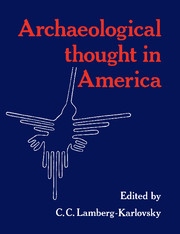Book contents
- Frontmatter
- Contents
- List of illustrations
- Introduction
- Part I History, method, and theory
- Part II Archaeology in the Americas and beyond
- 9 The structural analysis of Paleolithic art
- 10 Ancient China and its anthropological significance
- 11 Settlement pattern studies and evidences for intensive agriculture in the Maya Lowlands
- 12 The political economy of the Inka empire: the archaeology of power and finance
- 13 An epigenetic view of the Harappan culture
- 14 The use and abuse of world systems theory: the case of the “pristine” West Asian state
- 15 Mesopotamia, Central Asia and the Indus Valley: so the kings were killed
- 16 New tracks on ancient frontiers: ceramic technology on the Indo-Iranian Borderlands
- 17 Pastoralism and the early state in Greater Mesopotamia
- References
- Index
17 - Pastoralism and the early state in Greater Mesopotamia
Published online by Cambridge University Press: 06 July 2010
- Frontmatter
- Contents
- List of illustrations
- Introduction
- Part I History, method, and theory
- Part II Archaeology in the Americas and beyond
- 9 The structural analysis of Paleolithic art
- 10 Ancient China and its anthropological significance
- 11 Settlement pattern studies and evidences for intensive agriculture in the Maya Lowlands
- 12 The political economy of the Inka empire: the archaeology of power and finance
- 13 An epigenetic view of the Harappan culture
- 14 The use and abuse of world systems theory: the case of the “pristine” West Asian state
- 15 Mesopotamia, Central Asia and the Indus Valley: so the kings were killed
- 16 New tracks on ancient frontiers: ceramic technology on the Indo-Iranian Borderlands
- 17 Pastoralism and the early state in Greater Mesopotamia
- References
- Index
Summary
During the period leading up to the field project described in this chapter, the role of the highlands and more specialized pastoral adaptations in the emergence of Greater Mesopotamian alluvial civilization had been an area of much speculation, fueled by alluring but often obscure references to highland peoples and cultures in the documentary and literary record. Hinz had postulated the existence of a highland/lowland symbiosis which took the political form of confederation and provided the basis for the Elamite state structure (Hinz 1964: 3–4). R. McC. Adams had discussed the continuum connecting pastoralists, agriculturalists and urban populations. The chronic flux and local instability of these populations, he believed, may have played an important role in the growth of the Mesopotamian state (Adams 1974b: 3). A similar, integrated view of nomad and settled in the Mesopotamian heartland during the formative state phase was suggested by Nissen (1971). Others raised the possibility that highland nomadic pastoralists provided the impetus, in the form of military pressure, which pushed Elamite chiefdoms to transform themselves to state-level societies (Wright et al. 1975).
Although some of the speculative suggestions were statically ecological in nature, some scholars, particularly Lees and Bates, building on Adams's model, suggested a more historically based ecological picture (Lees and Bates 1974). They hypothesized that an increasing and specialized nomadic sector could not exist outside and independent of a specialized agricultural sector.
- Type
- Chapter
- Information
- Archaeological Thought in America , pp. 280 - 301Publisher: Cambridge University PressPrint publication year: 1989
- 6
- Cited by



